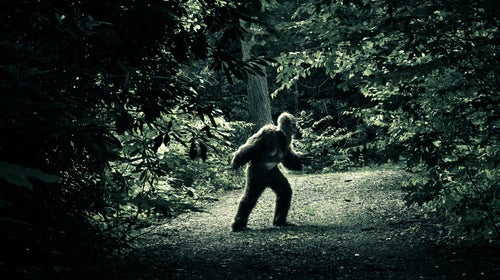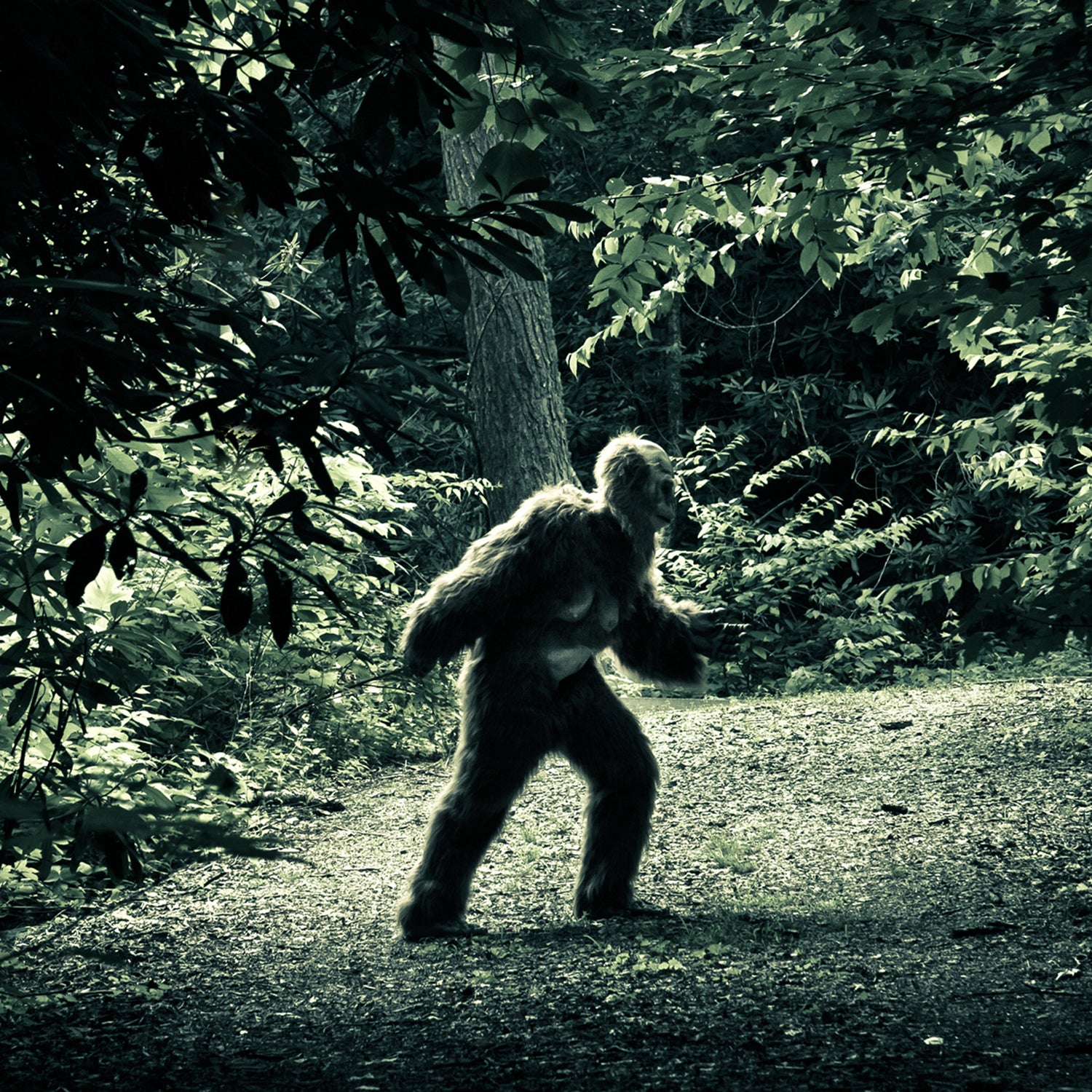The names vary by region and by peoples, but the descriptions are similar enough: a biped with an ape-like gait, roughly the size of a large human, with lots and lots of fur.
People have been spotting Sasquatches or Yetis or Abominable Snowmen for centuries,��and legends of these enormous primates populate the myths and fairytales of cultures on nearly every continent. It’s only recently, however, that man has made a study of what Americans usually call Bigfoot. In the decades after Robert Gimlin and Roger Patterson captured their famous footage, cryptozoologists—self-identified scientists who study unproven anthropomorphic animals—and ‘squatch hunters have carried out a Linnaean effort to classify the Bigfoots of the world and create a legitimate Bigfoot taxonomy. The result is a surprisingly clear profile of a creature that may or may not exist.
Note: Nearly all of the following is roundly dismissed by scholars and biologists.1 But that hasn’t stopped generations of Bigfoot experts from soldiering on.
1. Etymology
The term “Sasquatch” is an Anglicization of the Halkomelem Indian “sásq’ets,” a word tribes in the Pacific Northwest used to refer to mythological hairy giants. The English bastardization likely comes from J.W. Burns, an American teacher and early Sasquatch enthusiast who collected “wild men” stories from the local Chehalis tribe in Northern Washington.
The name “Bigfoot” was coined on October 5, 1958, by Humboldt Times editor Andrew Genzoli in a column about extraordinarily large footprints sighted near town—about nine years and 90 miles from where Patterson and Gimlin filmed the creature.
Though other regional names for the creature are in use—Booger (in the American South), the Ohio Grassman (common in the Midwest), MoMo (short for Missouri Monster), Nape (North American Ape), and the Yeti (in frigid climates)—according to , “scientists and folklorists looking to bring respectability to the subject” have recently opted to use “the more scholarly-sounding term ‘Sasquatch,’” rather than Bigfoot or other local names.
2. Taxonomy
There is not one single Bigfoot frightening hikers and campers across the world. Instead, researchers say, the Sasquatch is likely one of several species of hominid that have secretly lived alongside man for centuries. Leaders in the field disagree on the number of species and exact classification of the animal, however.
Within the United States, researchers believe there are likely more than one species of giant hominid. Estimates range from four distinct types in North America—some more ape-like than others—to at least 11 in The Field Guide to Bigfoot. Around the world, there may be nine-to-ten local unknown hominid species, on Sumatra to the very of the Caucasus Mountains.
The hominid’s origins are hotly contested.2 One popular theory, most prominently argued by , holds that Bigfoot is a modern descendent of Gigantophithecus, a species of ape that lived between 15 million and 100,000 years ago. Other presumed extinct hominid species, such as , have been linked to Bigfoot. Researchers including William Jevning, who has been tracking Sasquatch for 40 years, believe the creature may be a holdover from the Neanderthal population, though no fossil evidence of Neanderthals exists in the Western Hemisphere.
3. Physical Characteristics and Behavior
The Bigfoot species best known to Americans, seen in the widely disseminated Patterson-Gimlin film, is what cryptozoologist Loren Coleman calls a Neo-Giant.
These Sasquatch range from six to nine feet tall, with “enormous barrel torsos” and 20 inch feet. They have small, pointy heads with pronounced sagittal crests and appear nearly neckless. They are covered with shaggy, short hair from head to toe and they are famed for their strength.3 The creature is known to hunt deer and forage; whether its diet includes humans is debated.
“They are probably the smartest, most elusive land mammal of all,” says Matt Moneymaker, founder of the Bigfoot Research Organization.
This classic Bigfoot is mostly nocturnal, has a large brain and is “highly vocal.” Male calls come in a deep baritone, says Moneymaker, host of Animal Planet’s Finding Bigfoot, though females vocalize at a higher pitch. The Field Guide to Bigfoot suggests the creature also produces high-pitched whistles, howls, and sounds, such as eeek-eeek-eeek,��sooka-sooka-sooka,�����Ի� uhu-uhu-uhu.4
4. Distribution
The Sasquatch’s range extends from northern California up to British Columbia. The creature is known to live in the dense forests of the Sierra Nevada and Cascade mountain ranges.
Sasquatches live in small familial groupings of two to four, though the occasional lone male is spotted, according to Jevning, who has tracked Bigfoots for four decades. The groups’ range is up to 500 square miles, though more than one group may live in overlapping ranges. Sasquatch movements often follow the migratory patterns of deer herds, which they track and hunt.
Other separate Sasquatch species also occupy the American south (home of ), the Midwest, (, a species identified by the shaggy hair that covering its eyes), and the Great Lakes region (where ). Around the world, Sasquatch species have been identified in Scotland, Russia, China, Sumatra, and Australia.
While experts agree Sasquatches must maintain a breeding population to survive, their total numbers are uncertain.5 Krantz estimated that there is roughly one Bigfoot for every 10,000 bears in the continental United States, an approximation that would put their numbers at a little under 100.
5. Relationship with Humans
Sasquatches have evolved to evade humans, experts agree, and this trait combined combined with the animal’s constant movement has led to relatively few human interactions. The creatures are also very protective of their territory. “They’re extremely sensitive to human activity,” says Jevning. “If you disturb the area where they’re in feeding, they might not go back for decades.”
Sasquatches are known to throw rocks or branches at humans intruding on their hunting or mating grounds, though the extent of their aggression is disputed. Moneymaker, who says he has seen this behavior in Bigfoots numerous times, believes the actions to be defensive. “They won’t hurt you. Worst they’ll do is make scary sounds and throw rocks,” Moneymaker says. “They’re smart enough to know that they’ll get killed or seen by more people. What they want is to scare you so you never come back to that piece of woods. They throw rocks you’ll never seen coming.”
Jevning disagrees. “They can be very violent,” the tracker says. “They’re not the friendly forest giants some people say.” Jevning says law enforcement sources have informed him that Bigfoot attacks have led to multiple human deaths, including several recent incidents.6
Others believe that there is a dichotomy in Bigfoot behavior in the United States, noting that while the creatures of the Pacific Northwest are fairly peaceful, the Eastern varietal lives in much closer proximity to humans and is therefore forced to interact more often. “In the East, with over population, more dogs, you have more violence,” Coleman says. “They’re just angry all the time because they’re sharing the land.”7
6. In Culture
For centuries, the Sasquatch inspired dread. Many cultures told stories of “wild men” that carried off children who ventured too far into the woods and abducted women from villages. The widespread nature of these fables, experts contend, prove the tales they are not coincidence. “Fairytales are echoes of long forgotten stories passed down from generation to generation,” Jevning says.
Today, Bigfoot is a cultural icon. He is �����Ի� , a star of . But those who see the creature must live with the consequences, says Coleman. To be a Bigfoot believer often invites ridicule, or worse. “An experience like that means people lose their jobs, their lives, their relationships,” he says. “It’s so crazy-making that they cannot put it into any context in their life—where does this fit? It’s a very negative experience. Most people do not talk about it.”
Footnotes
1. Says G.W. Gill, former president of the American Board of Forensic Anthropology: “Either the most complex and sophisticated hoax in the history of anthropology has continued for centuries without being exposed, or the most manlike and largest non-human primate on earth has managed to survive in parts of North America and remains undiscovered by modern science.”
2. The unregulated, unproven nature of the Bigfoot field has led to many clashes of personality. “One thing I do not like in the field is the jealousy,” says Coleman, who notes that theories are often discredited or tossed aside because people “wish they had a successful T.V. program.” Jevning, for his part, says that most self-proclaimed Bigfoot experts are “attention whores.”
3. Compiling a reliable description of Bigfoot is, for obvious reasons, a difficult endeavor. But in addition to the limited number of sightings, experts must also contend with a number of faked reports from attention-seekers. Enormous plaster Sasquatch foot molds can be bought on Ebay,��for instance, so experts compare reports for discrepancies to find fakers. “Did time slow down or go missing? That’s not Bigfoot, that’s a UFO or whatever,” says Jevning.
4.��Oregonian outdoors columnist Bill Monroe, who heard Bigfoot vocalizations on an elk hunt, found the calls more unnerving. “The deafening screaming, choking, belching moan from the ridge was chilling,” he wrote. “The kind of scream that sends mothers scurrying to find their children. The kind of scream no cougar or bear could ever squeeze from their throat… unless it was their last. Piercing, echoing, guttural; a single, horrible high-pitched-yet-throaty, inhuman, unnatural creation of Steven Spielberg that makes your skin crawl.”
5. Coleman says researchers have been reluctant to study Bigfoot mating patterns or behavior. “The notion that the Bigfoot is the closest unknown animal to us led to a sort of prudish attitude” in researchers, Coleman says, though that’s now changing. “People are more and more open about all kinds of cases—a Bigfoot in Pennsylvania having sex with a bull or cow, a report in Oregon where a couple Bigfoot females were found together masturbating. We don’t know how important all of this information will be later on. We really need to collect everything and not discriminate against any of it.”
6. The most recent, Jevning says, took place in Washington State: “Lady disappeared from a vision quest up there, [near the] Washougal River. They ate her. Wasn’t much left. Official story is that she wasn’t found; I know through my contacts the remains were found—a few fingers and toes and skull cap.”
7. In August of 1965, alternative magazines across the country published stories on what Coleman calls the quintessential example of humans encroaching on Bigfoot land. A 17 year-old named Christine Van Acker was driving through Monroe, Michigan with her mother when they ran into a giant hominid. According to reports, “a huge hairy hand” reached into the car window and punched Van Acker until she was unconscious.


